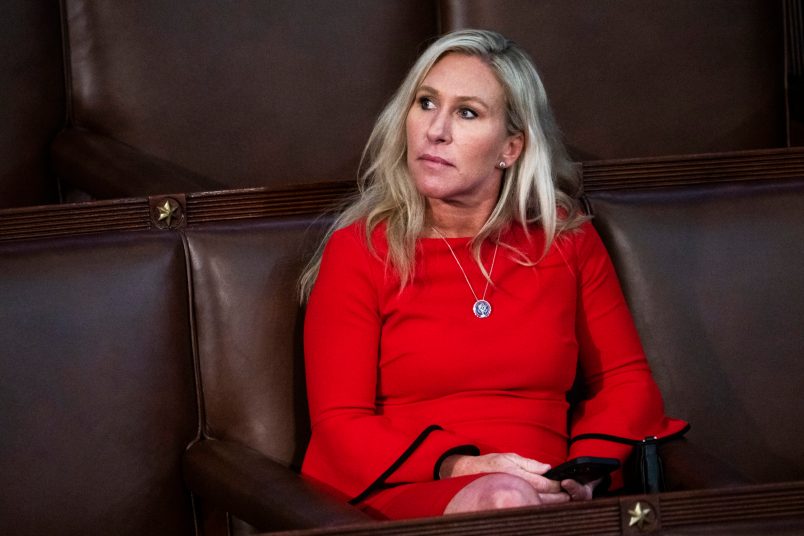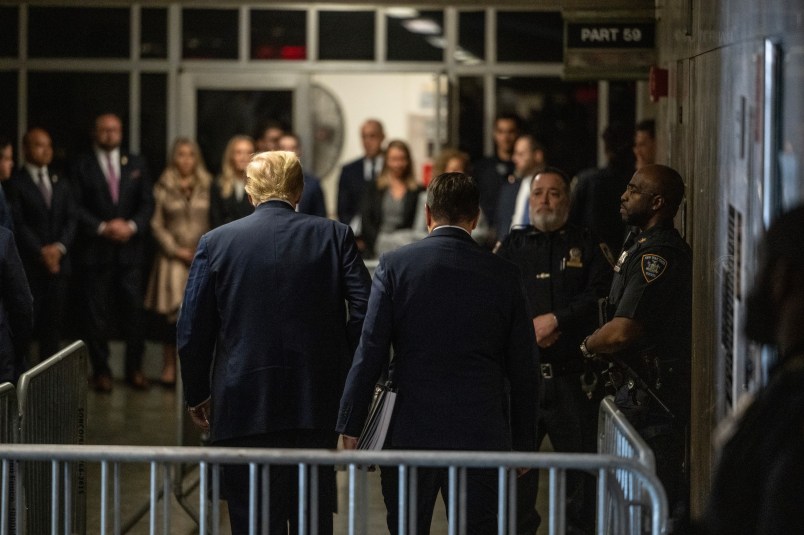The 2020 presidential election is an election with everything on the line for the United States. Four years of Trump is a national disaster. Eight years is a confirmation that it was no fluke. It embeds his degenerate style of government in the fabric of the Republic for the future. For those of us who believe in civic republicanism and a liberal future, no stone can be left unturned to ensure his defeat. It’s not just that the stakes are so high. He has big advantages in the electoral college. Incumbents usually get reelected. And let’s be frank: he already did once what many of us thought was all but impossible.
But we’d be lying to ourselves if we didn’t recognize another possible scenario, one which a lot of the factual evidence suggests is not at all unlikely. That is that Trump is a historically unpopular president; he routinely polls over 50 percent of the voting population saying they will definitely vote against his reelection; and he is likely to be crushed in his bid for reelection in 18 months.
Is all of this wishful thinking? Again, I’m not saying it will happen. I’m saying it’s a pretty plausible scenario. It’s probably best that no one who recognizes the importance of Trump’s defeat even thinks about it frankly. Assume you’re behind. But just between you and me, let’s briefly go through it.
Start with the most obvious fact: President Trump is the most consistently unpopular President in at least a century. He has not had a net positive approval rating for his entire presidency and has durably had approval ratings in the low 40s, sometimes dipping down into the 30s.The consistency of his unpopularity rather than its depth is what sets him apart. Other presidents have been that low and even gone on to win reelection. None has been that low for his entire presidency. That suggests a strong ceiling he cannot get above. For any other President we’d recognize this as a massive reelection warning sign. It’s really no different or shouldn’t be any different with President Trump.
The intensity of opposition is even more telling. Polls routinely show that well over 50% of voters say they will definitely not vote for him for reelection. A Quinnipiac poll from a week ago found that Trump had a 41% approval rating while 57% disapproved of him. More significantly 54% said they would “definitely” not vote to reelect him. A January Marist poll had the number of definite nos at 57%.
Could people change their minds? Of course. But this is a measure of the steepness of the climb. Trump needs to get all the undecideds and then peel off a significant number who say there’s no way they’d ever vote for him. That’s hard.
These are again, massive warning signs for reelection defeat.
Of course we know from bitter experience that a Republican President can lose the popular vote by a significant margin and still be elected President. But they can’t lose by that much. Maybe it’s 2 or 3 percentage points max to lose the popular vote and win the electoral college. But not more than that.
Here’s another way to look at it. President Trump won the 2016 election by sweeping most of the Bush/Obama era swing states and pulling off narrow surprise victories in Michigan, Pennsylvania and Wisconsin. In a more realist scenario, I suspect the entire election probably comes down to who wins Wisconsin. I’m not sure there’s been any public 2020 polls there yet. But we should remember that Scott Walker came really, really close to winning reelection even at the height of the 2018 wave. So Wisconsin is the nut Democrats need to crack and they need to put everything into it. There’s been a decent amount of public polling in Michigan and Pennsylvania though. The results for Trump are dismal. Trump is down by upwards of 10 points in Pennsylvania against Biden and Sanders. Michigan is about the same. If Trump loses these two states and Wisconsin he’s almost certainly done.
Then there’s red states. As you likely heard, Quinnipiac had a poll out this week showing Joe Biden beating President Trump by 4 percentage points in Texas. Biden was the only Democratic candidate to best Trump in the poll. The rest of the other top five candidates were just behind Trump with thin margin of error deficits. The headline here isn’t really Biden. His being a significant notch ahead of the other candidates is a pattern we see in virtually every poll. That may persist or not. The real headline here is that at least on the basis of this poll Trump will have to fight hard for Texas, which again suggests he could be on track for a crushing defeat.
Is this just an outlier poll? Not necessarily. An Emerson poll from a month earlier only had Trump doing a bit better. Biden was winning by 1 percentage point. Sanders losing by 2, Warren losing by 6 and so forth. Same basic picture. Trump has a fight on his hands in Texas.
Big red pulsing reelection warning sign.
We have very thin statewide polling at this point in the cycle. Like I said, I couldn’t even find a single poll of Wisconsin, which I suspect will be the pivotal state. And quite a lot can change in 18 months. But at least for right now statewide polls in critical states almost all show Trump behind. Arizona, the single pollster has Biden up by 5. Iowa, Biden up by 6. North Carolina, Biden by 12. Ohio hasn’t been polled since November, just after the midterm. That most recent poll had Biden up by 4. Interestingly, the best number I found for Trump in any semi-swingable state was Florida where the most recent poll had him tied with Biden. Given that Republicans won the governorship and the Senate seat last November, amidst a blue wave, it’s a pretty open question whether Florida is really any longer a swing state.
(I’m not trying to prejudice the primary question by mostly citing Biden’s numbers. It just provides a simple baseline apples to apples comparison. Usually Sanders is a bit weaker versus Trump and the remaining top three (Harris, Warren and Buttigieg) are a few points weaker. Whether this consistent spread changes over time we’ll have to wait to see.)
In what seemed like going on offense but actually betrayed the weakness of his position, Trump’s campaign just announced their intent to target New Hampshire, New Mexico and Nevada to ‘expand the map’ for 2020. New Hampshire is a perennially close run thing: I don’t think Trump will win there. But he could. New Mexico and Nevada are purely aspirational targets for Trump and that’s generous. Even his campaign, always full of bombast and chest thumping, seems to recognize it needs a new plan with most of the industrial midwest turning against him.
Some people say, well, look what happened with the polls in 2016! The polls don’t matter. Not really. The vast majority of what we’re talking about with ‘the polls’ for 2016 were the national horse race numbers. Consider one example. The final RCP average in 2016 had Clinton winning the national popular vote by 3.2%. She won it by 2.1%. Polls can be wrong. But they’re usually pretty close to predicting the result, especially when you average them out. In 2016 they were actually quite close to the mark, though they very slightly understated Trump’s strength.
Let me repeat. I’m definitely not saying all these polls will be predictive of the final numbers in November 2020. I certainly don’t want anyone to rely on that outcome – much better to consider these numbers for 15 or 20 minutes and then forget you ever read this post. As noted above, Trump has a number of advantages in his favor while the consequences of his possible reelection are so catastrophic that everything must be done to prevent it. But the constant repetition of the idea that Trump can be a complete maniac and buffoon but none of it matters because of the electoral college or other magic powers becomes at a certain point enervating and demoralizing for those who see the danger he represents and the necessity of his electoral repudiation. There’s little evidence to back it up. The truth is that we’ve all been collectively traumatized by the events of the last four years. Our judgment and perceptions are a bit off.
Personally, even I don’t really buy it. I assume it will be a tight race and the winner of Wisconsin will be the next President. But sometimes it makes sense to step back and look at data, albeit imperfect, which is separate from our hopes and fears. It’s like what pilots are trained to do in stormy weather or difficult flying conditions: ignore what you feel or see and just watch the instruments. The best summary is this. If you look at these numbers and set aside the name Trump and all the aura – negative and positive – that surrounds him, you would say the electoral beatdown scenario is significantly more likely than even a narrow victory for the President.
For now, forget I said any of this and focus on ending the Trump presidency. But keep it somewhere in the back of your mind because it’s probably true.









